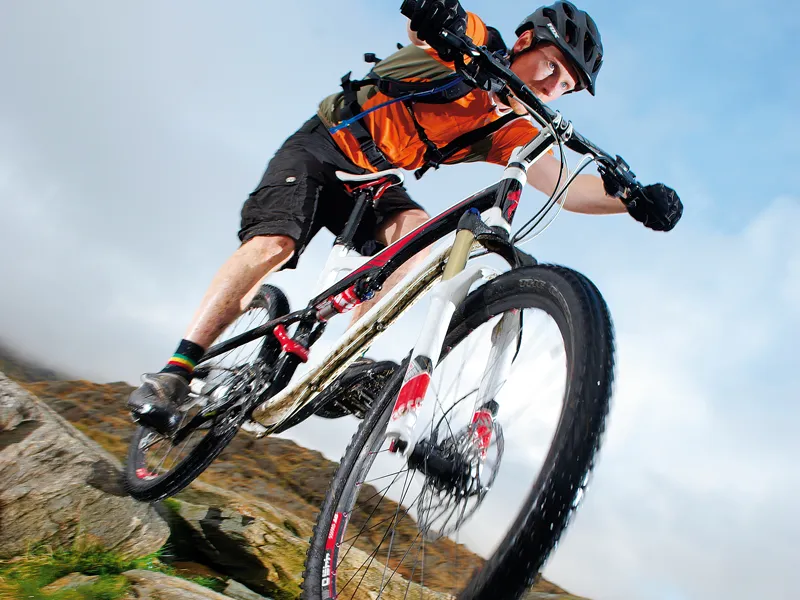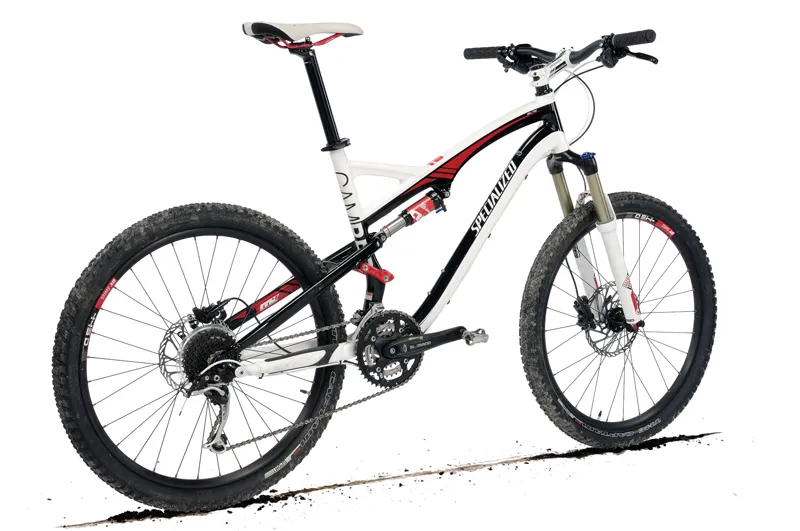This year, with the Stumpjumper FSR moving up to 140mm travel and the race-developed Epic staying at 100mm, Specialized found themselves with a gap in their full-suspension range. Which is where the new-from-the-ground-up Camber comes in, and it's a great all-rounder.
While a better fork would be worthwhile, the Elite’s frame offers a beguiling combination of mile-munching pace with grin-making downhill prowess. It was always going to be tough to fill the Stumpjumper’s shoes as a do-anything, go-anywhere trail bike, but the Camber Elite is only a fork upgrade away from doing the family proud.
Ride & handling: Fast, comfortable and efficient regardless of the speed or trail conditions
From its minimalist design to the reasonable weight and efficiently stretched out ride position, there’s no mistaking the fact that the Camber’s DNA is more cross-country than all-mountain. It’s got the same lithe pedal responses as many shorter-travel cross-country race bikes, surging forward with each pedal stroke in a way that belies the travel on tap.
Efficiency-obsessed riders may find the rear suspension’s active nature a bit off-putting, but the small amount of bob that’s there is only noticeable if you look down at the shock while you’re pedalling. If it’s a problem, flicking the gate switch on the RockShox shock to ‘on’ reduces pedal-induced bounce to practically nothing.
This efficient forward propulsion isn’t hindered by lumpy bits of trail. Point the Camber up a rocky climb, give it some welly and the rear wheel tracks over whatever’s in the way. Seated climbing at quad-burning intensity mops up swathes of technical trail at surprising speed. Once on the descent, the rear end is just as happy fending off (almost) anything you put in its path.
The same can’t be said of the fork. It puts up a valiant effort, but the budget internals are no match for the rear end’s alacrity and the lack of a screw-through axle makes the steering less precise than it should be. Then there’s the audibly squidgy rebound stroke. It’s not enough to rule the Camber Elite out of contention, but does knock it off the top of the podium.
Frame: Neat and minimal
The Camber Elite FSR can trace its ancestry back to arguably the world’s first production mountain bike, the 1981 Specialized Stumpjumper. Aside from the fact that both bikes share two wheels, handlebars, a saddle and some gears and brakes, superficially there’s little to link them. But the original Stumpy eventually inspired the 1995 FSR full-susser, whose basic workings are very similar to the Camber’s. The shock technology has moved on, but the principle of trail-friendly, efficient full suspension design remains the same.
Specialized’s proprietary M4 aluminium tubing graces the Camber’s frame with a selection of carefully hydroformed tubes. Up front, it’s all about curves. The ‘S’ shaped down tube strengthens and stiffens the bike’s backbone without the need for extra reinforcing gussetry, while a kicked back seat tube accommodates the minimalist forged rocker arm pivot without any extra chunks of metal or unsightly welds. There’s even cable routing for an adjustable height seat post. It’s all very neat.
The suspension, however, is all about straight lines. Specifically, the straight line you can draw from the rear axle, along the seatstays, through the shock and up the top tube to the head tube. Specialized claims this results in better small-bump response and reduced weight. We’re not going to argue – it’s certainly incredibly tidy and noticeably reduces the number of components needed to drive the rear shock.
Cable routing has always been the bane of the suspension bike designer’s life. Like many manufacturers, Specialized have stopped trying to build in slotted guides and have introduced full-length cable runs instead, held on with a mix of zip ties and bolt-on guides. It’s arguably less elegant, but also less prone to water and grit ingress and easier to replace.
Sealed cartridge bearing pivots are less prone to wear than simple bushings and should, in theory, last longer. Like all bearings, though, they’ll wear eventually and, because they’re sealed, they’re non-serviceable and non-adjustable. If your Camber’s rear end develops a sloppy feel, it may be time to replace the bearings.
Equipment: Recon fork’s so-so performance hold things back
RockShox provide air springs at each end, with bob-reducing gate controls and adjustable rebound damping. Like every Recon fork we’ve ridden recently, our test sample featured a noisy rebound stroke that spoilt the bike’s otherwise composed trail manners. While it’s not up to the standards set by RockShox’s better forks, the Recon will do the job reasonably well – albeit a tad noisily – while you save for an upgrade.
Own-brand finishing kit provides rider and trail contact points, and we’ve no complaints with the Shimano transmission and Avid brake system in spite of the Alivio shifter downgrade. In a bid to colour coordinate the Camber’s componentry to the nth degree, Specialized’s product managers have given the wheels red anodised spoke nipples. While it looks good, aluminium nipples are far more prone than brass ones to rounding off, should you ever need to true the wheels.

